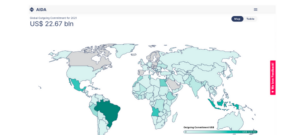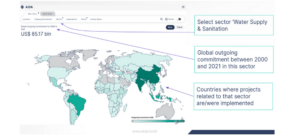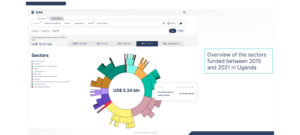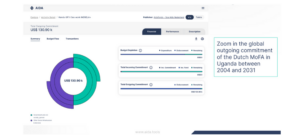
This Recap is written by Miriam Allam, Senior Advisor – Open Data Company
During the session, we particularly highlighted the opportunity that each IATI publisher has when one starts publishing. Once your data is out there and available according to a data standard like IATI, it is possible to use and reuse it for many different purposes. And using a standard also provides the opportunity to start comparing, aggregating and using data across organisations, providing a more inclusive view of what is happening in terms of development interventions. By analysing and visualising open aid data, NGOs can unlock the potential of making more data-driven decisions and responding faster and more informed to change.
How can Open Data contribute to the increase of impact for NGOs?
Many nonprofits are missing out on opportunities to collect and use open data effectively. Understandably, their first focus is on the implementation of programmes and on the here and now, while it is also commonly known that the context in which the development sector operates is extremely volatile. In such a set-up with a high likelihood of unexpected changes occurring, it is important to be adaptive and flexible. Real-time data and data analysis in particular can strongly support NGOs to increase their adaptability and resilience to respond to change. Indeed starting to use (open) data as a resource for program design, management and planning can allow NGOs to:
- save time and resources in data collection and project management, while making data-driven decisions;
- increase the opportunities to identify relevant funders and partners in a certain context;
- respond faster to changes in the context, making programs more relevant and effective;
- coordinate aid interventions with stakeholders to stimulate efficient use of scarce resources.
How the IATI open data standard helps NGOs reach more impact
The International Aid Transparency Initiative (IATI) is a global open data standard that aims to improve the transparency of the work of development and humanitarian organisations in addressing poverty and crises. IATI is perceived by many as an additional administrative burden requirement and nothing more, therefore not realising the full potential of IATI data as a way to standardise data across organisations. Using data in a standardised way saves time and resources which are now used for. By making proper use of the standard an NGO can avoid having to digest loads of information to come up with one donor report. Once published the data can be used to communicate your results and adapt your programs quickly. Also, it can support you to compare and analyse beyond your own organisation’s efforts, identifying new opportunities or threats.
What is the added value of the AIDA platform?
Reporting IATI data can be a time-consuming process. The Aid Information Data Analytics (AIDA) portal is an all-in-one tool to help you with all your IATI needs in a user-friendly way. AIDA allows you on one platform to:
- Publish your data using easy-to-use spreadsheets,
- Validate against the IATI Standard and
- Visualise your and all IATI data.
Indeed, the AIDA portal is a visualisation layer on top of all the available IATI data in the IATI datastore, containing currently over 1.000.000 activities of 1300+ development agencies worldwide.

With AIDA, we aim to unlock the potential and richness of all IATI data providing tooling for anyone to access, use and search it. AIDA has transformative potential, including information on SDGs, as anyone (with no IT skills required) can view, filter and visualise and execute analysis on the total aid interventions of development agencies from all countries on a single data services platform.
The AIDA platform: a solution for NGOs to start using IATI data
In our longstanding support work having supported NGOs worldwide by publishing their IATI data, we notice that publishers do not take enough advantage of all of IATI´s benefits. They view IATI as a reporting requirement and do not take it as an opportunity to make evidence-based decisions that will untimely help them to reach their goals in a more data-driven, effective and efficient way.
The visualisation of IATI data on the AIDA portal helps organisations combine, benchmark and communicate different insights based on several interests. The data can be presented to different stakeholders in a more meaningful way but it can also help you to work more efficiently. Here are some examples of useful insights that can be found on the AIDA portal.

As a program manager, you can visualise countries where similar programmes are happening, activities that are/were implemented in a country, stakeholders active in specific sectors/ countries (downstream & upstream)

As a fundraiser, on AIDA, you can quickly visualise donors already funding the same type of projects, sectors that are receiving funding and countries where a donor is active:

As a PMEL Officer, you might like to visualise project and result progress, financial flows overview (outgoing/incoming funds) and results reporting.
Check out these youtube videos to see what is most interesting to see in AIDA as a Fundraiser and what is most interesting to see in AIDA as a Project/ Programme Manager.
Experience in looking for open data on the AIDA platform
During the session, participants were able to test out the AIDA platform and get familiar with how the portal works. They searched for the data that they were interested in and tested several functionalities and visualisations of the platform. Searching, using and starting visualising the open data helps to identify what other organizations are doing and this was found to be a concrete advantage to their IATI reporting requirements. While the navigation felt accessible and easy to use, participants shared that the options to visualise the data offered too aggregated levels of information in the current BETA version of AIDA. The TODC team is currently working on adding more possibilities to break down the data analysis.
As general conclusion, the platform already provides robust visualization options, but to unlock its full user potential it needs further rounds of development with the end-user.
The AIDA platform will be enriched very soon with new functionalities and visualization options. Check out the SDG prototype and AIDA chart builder explanatory video to get a feel of what will be soon enabled on the AIDA platform. To ensure that these solutions match user needs, we are constantly searching for organisations that want to test and experiment with us.
If you are interested in exploring the AIDA platform, click here: https://www.aida.tools/